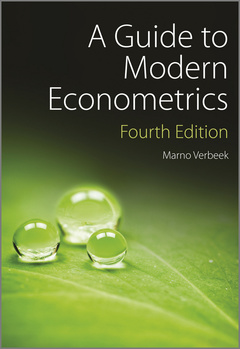Description
A Guide to Modern Econometrics (4th Ed.)
Author: Verbeek Marno
Language: English
Subject for A Guide to Modern Econometrics:
Approximative price 69.87 €
In Print (Delivery period: 12 days).
Add to cart512 p. · 17.5x24.2 cm · Paperback
Description
/li>Contents
/li>Readership
/li>Biography
/li>
The 4th Edition features:
- Coverage of a wide range of topics, including time series analysis, cointegration, limited dependent variables, panel data analysis and the generalized method of moments.
- Intuitive presentation and discussion, with a focus on implementation and practical relevance.
- A large number of empirical illustrations taken from a wide variety of fields, including international economics, finance, labour economics and macroeconomics.
- Increased focus on robust inference and small sample properties.
- End–of–chapter exercises, both theoretical and empirical, reviewing key concepts.
- Updated and expanded coverage, on various topics such as missing data, outliers, forecast evaluation, the estimation of treatment effects and panel unit root tests.
- Supplementary material, including PowerPoint slides for lecturers, data sets of the empirical illustrations and exercises, and solutions to selected exercises in each chapter, available at
1 Introduction 1
1.1 About Econometrics 1
1.2 The Structure of this Book 3
1.3 Illustrations and Exercises 4
2 An Introduction to Linear Regression 6
2.1 Ordinary Least Squares as an Algebraic Tool 7
2.2 The Linear Regression Model 12
2.3 Small Sample Properties of the OLS Estimator 15
2.4 Goodness–of–fit 20
2.5 Hypothesis Testing 22
2.6 Asymptotic Properties of the OLS Estimator 32
2.7 Illustration: The Capital Asset Pricing Model 38
2.8 Multicollinearity 43
2.9 Missing Data, Outliers and Influential Observations 47
2.10 Prediction 52
3 Interpreting and Comparing Regression Models 58
3.1 Interpreting the Linear Model 58
3.2 Selecting the Set of Regressors 62
3.3 Misspecifying the Functional Form 70
3.4 Illustration: Explaining House Prices 72
3.5 Illustration: Predicting Stock Index Returns 76
3.6 Illustration: Explaining Individual Wages 81
4 Heteroskedasticity and Autocorrelation 94
4.1 Consequences for the OLS Estimator 94
4.2 Deriving an Alternative Estimator 96
4.3 Heteroskedasticity 97
4.4 Testing for Heteroskedasticity 105
4.5 Illustration: Explaining Labour Demand 107
4.6 Autocorrelation 112
4.7 Testing for First–order Autocorrelation 116
4.8 Illustration: The Demand for Ice Cream 119
4.9 Alternative Autocorrelation Patterns 122
4.10 What to do When you Find Autocorrelation? 123
4.11 Illustration: Risk Premia in Foreign Exchange Markets 127
5 Endogenous Regressors, Instrumental Variables and GMM 137
5.1 A Review of the Properties of the OLS Estimator 138
5.2 Cases Where the OLS Estimator Cannot be Saved 141
5.3 The Instrumental Variables Estimator 148
5.4 Illustration: Estimating the Returns to Schooling 154
5.5 The Generalized Instrumental Variables Estimator 158
5.6 The Generalized Method of Moments 166
5.7 Illustration: Estimating Intertemporal Asset Pricing Models 171
6 Maximum Likelihood Estimation and Specification Tests 179
6.1 An Introduction to Maximum Likelihood 180
6.2 Specification Tests 189
6.3 Tests in the Normal Linear Regression Model 195
6.4 Quasi–maximum Likelihood and Moment Conditions Tests 199
7 Models with Limited Dependent Variables 206
7.1 Binary Choice Models 207
7.3 Models for Count Data 231
7.4 Tobit Models 238
7.5 Extensions of Tobit Models 247
7.6 Sample Selection Bias 257
7.7 Estimating Treatment Effects 260
7.8 Duration Models 268
8 Univariate Time Series Models 278
8.1 Introduction 279
8.2 General ARMA Processes 284
8.3 Stationarity and Unit Roots 289
8.4 Testing for Unit Roots 291
8.5 Illustration: Long–run Purchasing Power Parity (Part 1) 300
8.6 Estimation of ARMA Models 304
8.7 Choosing a Model 306
8.8 Illustration: The Persistence of Inflation 311
8.9 Predicting with ARMA Models 314
8.10 Illustration: The Expectations Theory of the Term Structure 320
8.11 Autoregressive Conditional Heteroskedasticity 325
8.12 What about Multivariate Models? 333
9 Multivariate Time Series Models 338
9.1 Dynamic Models with Stationary Variables 339
9.2 Models with Nonstationary Variables 342
9.3 Illustration: Long–run Purchasing Power Parity (Part 2) 348
9.4 Vector Autoregressive Models 350
9.5 Cointegration: the Multivariate Case 354
9.6 Illustration: Money Demand and Inflation 362
10 Models Based on Panel Data 372
10.1 Introduction to Panel Data Modelling 373
10.2 The Static Linear Model 376
10.3 Illustration: Explaining Individual Wages 394
10.4 Dynamic Linear Models 396
10.5 Illustration: Explaining Capital Structure 405
10.6 Panel Time Series 410
10.7 Models with Limited Dependent Variables 417
10.8 Incomplete Panels and Selection Bias 425
10.9 Pseudo Panels and Repeated Cross–sections 430
A Vectors and Matrices 441
A.1 Terminology 441
A.2 Matrix Manipulations 442
A.3 Properties of Matrices and Vectors 443
A.4 Inverse Matrices 444
A.5 Idempotent Matrices 445
A.6 Eigenvalues and Eigenvectors 445
A.7 Differentiation 446
A.8 Some Least Squares Manipulations 447
B Statistical and Distribution Theory 449
B.1 Discrete Random Variables 449
B.2 Continuous Random Variables 450
B.3 Expectations and Moments 451
B.4 Multivariate Distributions 452
B.5 Conditional Distributions 453
B.6 The Normal Distribution 454
B.7 Related Distributions 457
Bibliography 459
Index 477

